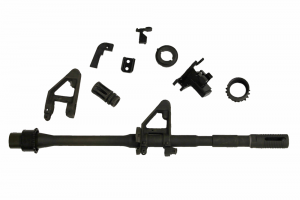The excavation at an ancient Roman fort in Germany in the 1940s shows how far back coating metals with phosphates goes. Several iron items were found in remarkably good condition, with their surfaces converted into a blue iron phosphate coating that resisted corrosion remarkably well over the millennia. The widespread use of phosphate coatings in modern society did not begin until the mid-19th century, however, with the discovery that hot iron treated with coal dust and potassium phosphate resisted corrosion. From 1869, a variety of methods for coating metals with phosphates to protect iron and steel from corrosion were patented, and the process became increasingly widespread. Zinc and manganese phosphate coatings – the two most common types of phosphate coatings – are now widely used for a number of industrial purposes.
What is Phosphate Coating?
Made up of a single phosphorus atom surrounded by four oxygen atoms, phosphate molecules are derived from phosphoric acid. Zinc phosphate molecules are made up of three zinc atoms, two phosphate molecules and four molecules of water, whereas manganese phosphate is composed of three manganese atoms and two phosphate molecules.
Today, zinc and manganese phosphate coatings serve as pre-treatments for metal prior to further coating or painting, helping paints adhere better to metal surfaces while additionally protecting electrically conductive metals for even better corrosion control. It can also be used as a final finish, but most frequently used as a pre-treatment. As per their original use, these phosphate coatings protect against corrosion, but also reduce friction in sliding components.
Because of their cost-effectiveness, phosphate coatings are the most widely used type of treatment for steel surfaces. While both zinc and manganese phosphate coatings protect metal components from wear and corrosion, manganese phosphate coatings have additional properties that make it preferred for most industrial applications.
Manganese Phosphate Coating
Found only in combination with iron and other minerals, manganese is an exceptionally rigid, brittle and grayish-white metal. A common element occurring throughout the Earth’s crust, manganese is also used in steel production and glassmaking.
Manganese phosphate coatings provide metal components with additional wear resistance and help them resist galling, also called “adhesive wear,” which occurs when surfaces touching each other stop working due to cold welding. By leaving a heavy crystalline finish, manganese phosphate coatings also help metal parts retain oil or other petroleum-based lubricants, which in turn improves anti-friction properties while imparting corrosion resistance.
Often manganese phosphate coatings are applied to bushings, bearings, fasteners, and other commonly used industrial components. Tending to be dark gray or black in color, these manganese coatings are particularly useful for systems like motor vehicle transmissions with sliding features, as well as with automotive clutch and brake assemblies, engine parts, and coil springs.
The Other Phosphate Coating
Zinc phosphate coatings mainly serve for items that require rust proofing, as manganese phosphate or iron phosphate coatings offer additional properties that zinc cannot match. Applied typically through immersion or spraying, they tend to be similarly colored, though generally lighter than manganese phosphate coatings.
Benefits of Manganese Phosphate Coatings
When compared to other coatings, manganese phosphate offers properties that improve the reliability and overall performance of metal components.
Magnesium phosphate coatings offer the following benefits:
- Allows secondary coatings and paint to adhere better
- Anti-galling properties
- Durability
- Facilitates cold-forming processes like wire and tube drawing
- Improves friction resistance, particularly for sliding components
- Offers hardest available phosphate coating
- Permits better absorption of lubricants
- Protects against corrosion
- Resists rusting better due to Insolubility in water
- Strong adhesion properties
Manganese Phosphate Coating Applications
There are numerous applications for manganese phosphate coatings, which are commonly used for components in engines, magnetic cores in electric motors, transmission systems and mechanical gears. The coating helps increase the service life for these various systems by reducing wear from friction and protecting against corrosion. Because of these properties, manganese coatings are also used for fasteners such as nuts, bolts, screws, and washers.
Contact Silvex Inc.
Silvex offers a large variety of advanced finishes processed to NADCAP, ISO 9001:2015, and AS 9100 and other standards for industries including defense, aerospace, hospitality, telecommunications, water purification, power generation, and much more. If you have questions about our manganese phosphate coating, please contact us at Silvex today!

